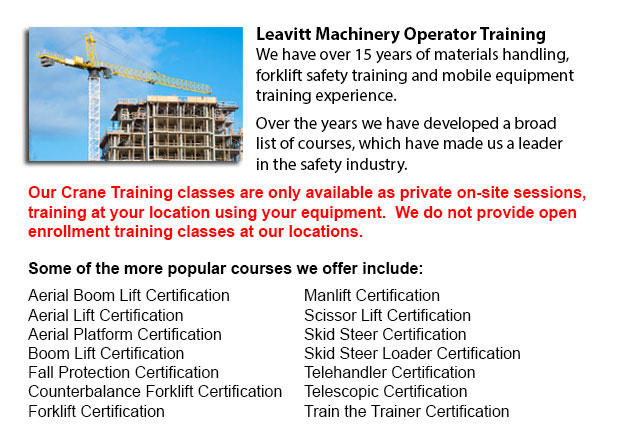
Kingston Overhead Crane Operator Training - Our overhead crane operator training program is intended to teach employees the fundamentals of overhead crane/sling operation and pre-shift checks. Programs are taught by our professional trainers and consultants. Well-trained staff are more productive and efficient, which saves on costs connected with product damage, property damage, and accidents due to the use of incorrect operating procedures. Our overhead crane certification is customized for workers who have literacy barriers, reducing certification time by 50 percent.
Overhead cranes are best for specific repetitive hoisting activities. This kind of crane has wide ranging capacities. They can be used for specialized lifting jobs like installing or removing major plant equipment.
Operators and worker have to employ safe rigging practices in order to safely operate an overhead crane. This will require both knowledge and practice since the load should be correctly rigged to guarantee its stability when hoisted. Before starting a hoisting task, it must be determined that the crane is suitable for the task, with appropriate travel, lift and capacity. The crane should be subjected to a thorough physical and visual inspection before utilization. The capacity of all machines, including the slings, hardware and rope, must never go over load weight capacities.
The rigger needs to know the right sling for each lift and inspect slings and other rigging hardware prior to using. Clear signals need to be used in communications with the crane operator. A signaler needs to be chosen for the role and signals have to be agreed upon. The crane operator should follow instructions from the chosen individual only. If a remote or wired controller is being used, the operator must be trained in all its functions.
In order to ensure the safety of workers, a warning must be issued and the path of the load must be cleared of all hazards before the lift starts. People should not be allowed to walk below the lift loads. The crane hoist has to be centered over the load prior to hoisting in order to prevent swinging. The safety catch has to be closed immediately after sliding the sling entirely onto the hoisting hook. Sling legs which are not used must be secured so they do not drag. Never leave loose materials on a load being hoisted. Watch that fingers and hands are clear when slack is taken out of a sling. Before the lift is carried out, step clear of the danger zone.
-
Narrow Aisle Forklift / Order Picker Training / Electric Pallet Jack / Electric Pallet Truck Training in Kingston
A pallet lift is a piece of equipment dedicated in the moving of pallets of various dimensions and weights. They might be utilized as an accessory for forklifts, cranes and other styles of heavy machinery or be applied on their own. Pallet lifts are... More -
Kingston Forklift Training School
Kingston Forklift Training School - Forklift Training School - Industry and federal regulators have established the criteria for forklift safety training based on their existing regulations and standards. People wishing to operate a forklift must fin... More -
Kingston Scissor Lift Certification
Kingston Scissor Lift Certification - Scissor lift platforms are utilized at work locations to enable tradespeople - such as iron workers, welders and masons - to reach their work. Making use of a scissor lift platform is usually secondary to their t... More -
Kingston Boom Lift Safety Training
Kingston Boom Lift Safey Training - Boom lifts are a type of elevated work platform or aerial lifting device that are normally utilized in warehousing, construction and industry. Boom lifts could be made use of in practically whichever environment du... More -
Kingston Fall Protection Ticket
Kingston Fall Protection Ticket - Fall-related incidents are the number one reason of death in the construction business. The possibility for fall accidents very much increases based upon the type of work which is being accomplished within your workp... More -
Telehandler Training in Kingston
Telescopic handlers normally called telehandlers for short, are an extremely popular piece of heavy construction machinery. They are widely utilized in the construction and agricultural trades. These machines have farthest reaching ability and are ab... More -
Kingston Warehouse Forklift Training Programs
Kingston Warehouse Forklift Training Programs - Warehouses could either be retail, industrial or commercial facilities, functioning from bulk product retailing to product distribution services. Regardless of the type of warehouse, personnel inside wa... More -
Kingston Heavy Equipment Ticket
Kingston Heavy Equipment Ticket - Depending on the nature of the job at hand, the kind of construction machinery that a heavy equipment operator utilizes varies. Every type of equipment is built to do particular jobs in the most effective method comm... More

Forklift Certification Kingston
TOLL FREE: 1-888-254-6157
Kingston, Ontario
forkliftcertificationkingston.com
Email Us
About Us


